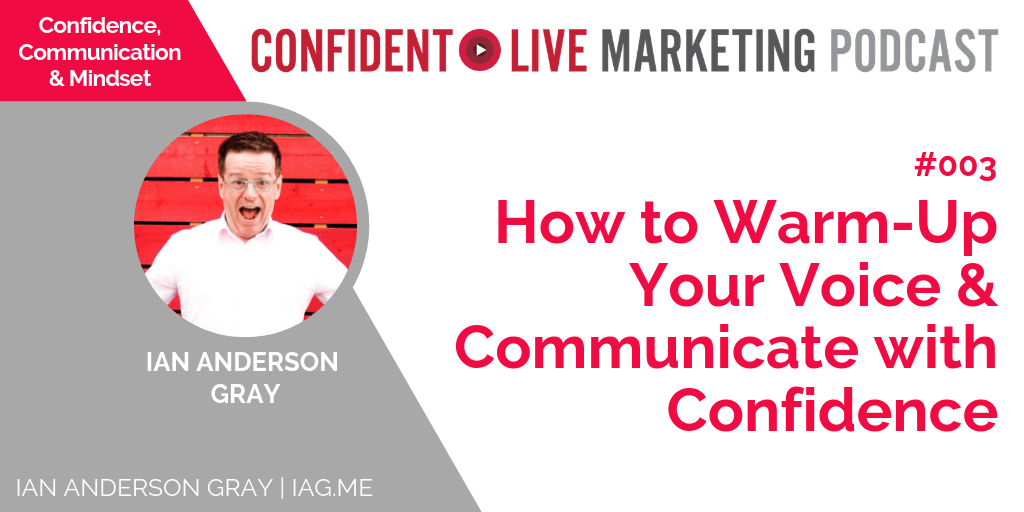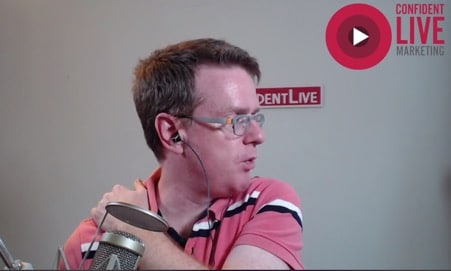How to Warm-Up Your Voice & Communicate with Confidence
[wpv-post-taxonomy type="podcast-names" format="name"]
Episode 3
Duration: 35 minutes 59 seconds
Episode Theme: Confidence & Mindset
June 7, 2019

When you broadcast live, do you do what most people do and focus on the “video”
That's what we look like… and not so much about how we sound.
In this episode, I’ll give you some tips on warming up your voice, how to improve your diction and communicate with confidence.
I'll be covering the following:
- Exercises to warm up your voice
- Posture
- Breath control
- Pitch interest
- Diction
Why is your voice important?
If you can improve the health and quality of your voice then you are going to be able to speak with much more conference and, more importantly, you won’t lose your voice!
Ultimately, we want to communicate with confidence, not sound boring and really work to engage our audiences.
Why do I know so much about this?
My working background is in technology, social media and building websites, but I am also a trained professional singer, I read music at university and then trained at the Royal Northern College of Music. I was singing in opera on stage, performing and was taught to communicate with confidence.
I would describe myself as an introvert and can be shy. Broadcasting live didn’t come naturally to me and I have had to work at it. However, my background in performance though has really helped me and I know that it will help you to.
The importance of posture
Ideally – you should be standing up when you are doing a live or recording a podcast. I know that this isn’t always possible – you may want a more informal feel where you are sitting on a sofa, or being out and about.
If you are sitting down – there are things that you can do about your posture still.
You can watch me demonstrate the exercises and routines I talk about in the live I did to record this podcast episode:
TIP #1 – Warm up your body
Much as you would do warm-ups before exercising if you were going to the gym – you would do the same for your voice before speaking.
Here is a little routine you can use to warm up. It’s called STRETCH SHAKE WIGGLE JUMP!
- STRETCH your arms UP to the ceiling and hold that position for 7 secs
- SHAKE your arms to loosen up your shoulders and arms.
- WIGGLE your legs
- JUMP and down to loosen up your legs
- STRETCH your arms OUT in front of you and hold that position for 7 secs
- SHAKE your arms to loosen up your shoulders and arms.
- WIGGLE your legs
- JUMP and down to loosen up your legs
- STRETCH your arms BEHIND you (stick your chest out) and hold for 7 secs
- SHAKE your arms to loosen up your shoulders and arms.
- WIGGLE your legs
- JUMP and down to loosen up your legs
TIP #2 – Take the ‘Noble Position’
The Italian school of opera, music and singing (quite a few hundred years ago) talked about the Noble Position. This is all about how you can really look confident – standing with shoulders down, chest and back erect and looking confident.
If you are shy, your shoulders drop and your chest goes in – you are hiding and retreating into yourself and create a barrier between you and your audience.
How to overcome this:
- Imagine you are a King or a Queen (or whichever suitable royal position you’d like!)
- Put your arms at your side and hang comfortably (falling with gravity)
- You head is straight up, and you are looking straight ahead at your ‘subjects’ (your audience)
TIP #3 – Remove the tension in your body
Tension in the upper body – particularly tension in the shoulders, neck and chest, can really affect your voice. It can tighten things up and put a lot of pressure on your larynx / vocal cords.
You may find you lose your voice easily and it also means that you’re not using your voice in the best way – so you’ll sound strained and people may find it difficult to hear what you are saying.
It’s important to loosen up your body. I like to do some massaging exercises, so try this:
Massage shoulder muscles and stretch your neck
Take your left hand and put it on your right shoulder and then look over your left shoulder. Now use your left hand to massage your (right side) neck muscle, while you are gently stretching your neck at the same time.
Repeat on the other side.
Focus on your neck muscles
Drop your head slightly – not quite to the floor, just gently look down. Take both hands and then just use your thumbs and fingers to rub your neck up and down. (You may end up yawning and closing your eyes – that’s ok!)
And then start to slowly look up and continue rubbing with your fingers – but drawing them forwards as you look up.
Spinal Drop
If you have done Pilates before, you will recognise this. You basically start from the top of your head and slowly tilt your head forwards, then shoulders, and then you try to slowly continue vertebrae by vertebrae down towards the ground.
Concentrate on your breathing and go slowly and as far as you can go. Then you repeat the process reversing and coming back up. Make sure you go nice and slow and carefully.
Final ‘reset’ of the body
Quite simply, put your hands above your head and then just let them fall down, with gravity, to either side of you. You should now be feeling quite loose and confident and ready to start your live.
If you are going to be sitting down – just make sure you are sitting with your back nice and straight.
Breath Control
I’ve noticed that some people, get nervous when they are speaking (particularly on podcasts or live video). They end up speaking really fast and taking in breaths quickly and they almost sound like they are hyperventilating.
What’s really important is that you control your breath and that you are expanding your lungs. As adults, it sounds silly, but we have forgotten how to breathe properly and tend to do more (lazier) shallow breathing.
What we need to do is use our diaphragm muscle to regulate our breathing. How’s what you can do to practice this:
- Put your hands just below your bottom rib – by the fleshy bit
- Press in quite firmly with your thumbs at the back and your fingers at the front
- Then breath in very slowly – into your hands, so your lungs expand
- Then slowly exhale letting it out as a “vvvvvvv” sound
If you don’t feel a lot of expansion at first – that’s ok, it will come with practice. When you take a breath in – we don’t want to hear you take in the breath. If you are still quite vocal / loud when you are breathing in – then you are putting pressure on your muscles.
Once you’ve done this once – repeat. When you do it again though I want you to try and slow down your exhaling, by counting for 6 secs…and then try 9 secs. This is a strengthening exercise – you will get better over time.
If you fancy an app that can help you with your voice warming up – I highly recommend One Minute Voice WarmUp (Android and Apple for £2.99/$2.99).
Pitch Interest
This is really important. Have you listened to a podcast or watched a video and the person is incredibly monotone and sounds quite boring – with no passion at all?
We want to add a bit of excitement in our voice in order to improve the listening experience and which will keep our audience engaged.
Here’s an exercise you can do to use the lows and highs of your voice and increase your range – it’s called the “Lip-trill” exercise:
(It’s probably better trying to watch this in my live video! Timestamp is 32:15mins)
- Get your lips nice and relaxed and then blow air through your lips (almost like a child blows a ‘raspberry’…but keep your lips more open)
- Then do ‘scales’….so go from the low to the high of your voice
Another one you can do is a more musical version – so singing (pretend to be an opera singer) la la la la la (and go and up and down).
Diction
This is all about getting your words out really clearly. Start to practice speaking slowly and enunciate your words. Over time you can speed that up – but start slow.
Some tips on how to practice this (listen in the podcast for full effect!):
TIP #1 – Practice your vowels
Look at the Italian vowel sounds – A E I O U. Make sure that your mouth shape is really over the top when you verbalise the sounds of the vowels. You will almost sound like a didgeridoo!
Add some pitch to your vowels and go up and down – have some fun with it.
TIP #2 – Consonants
Get some consonants’ together and then repeat them over and over. You are using your lips, teeth and tongue to produce these sounds.
You can come up with some tongue twisters to do this. I have come up with a couple of funny-sounding lines I use in my workshops and with clients. Try this one:
(Tune – is the William Tell Overture song)
Daddy’s got a head like a ping pong ball
Start slow…then try and go faster and faster.
Vocal health
Before you speak – it’s a good idea to avoid foods or drinks that can affect the quality and health of your voice. Things like dairy, alcohol, carbonated drinks and coffee can affect your voice. I find for myself – if I have dairy before I speak – it clogs up my throat.
Good things to do before you speak: try and have hot water with lemon(/honey), or a warm tea (not coffee). Try to drink lots of water.
Do you have any tips to share?
Do you have any exercises that you do or tips to share for how you look after your voice and project confidence? I’d love to hear them!
In the meantime, I hope you’ve found this a helpful episode – giving you some things to do to help you to communicate with confidence. If you have any questions please do pop a comment below, email me or come and join me on social media.





